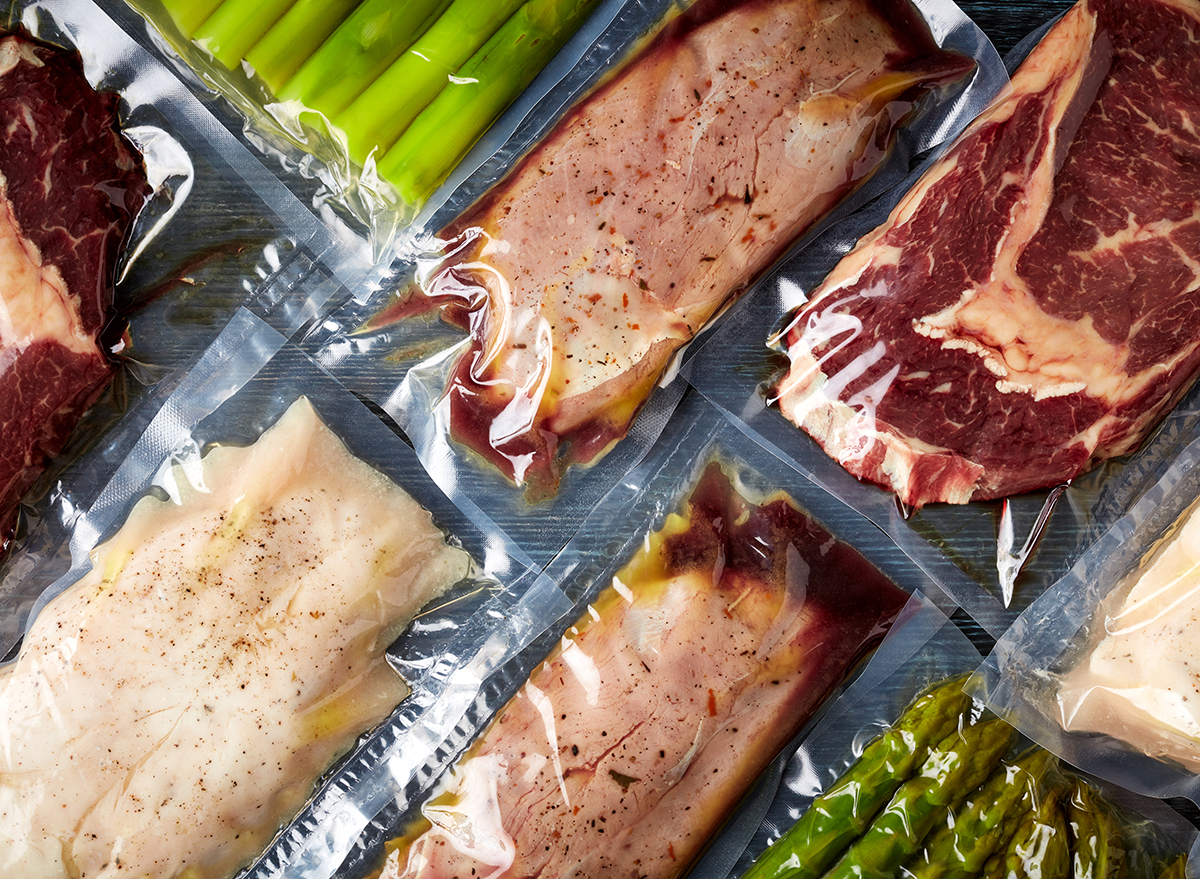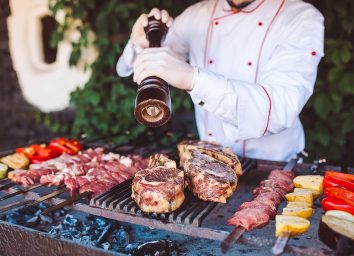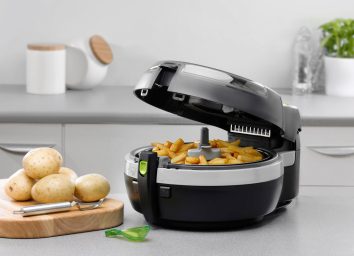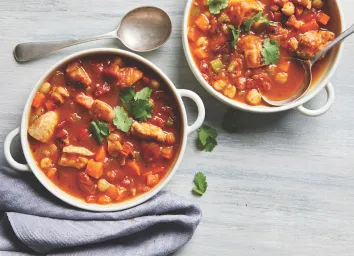Sous Vide: The Expert Way to Cook At Home

Let’s be honest, with our hectic schedules and fast-paced lives, whipping up a big meal on the daily isn’t even an option. Luckily, we live in a world filled with slow cookers, Instant Pots, air fryers, and other nifty cooking gadgets that have made life in the kitchen a lot easier. And just when you thought your home was stocked with the most up-to-date culinary technology and you’ve tried every set-it-and-forget-it method out there, we bet sous vide is still quite a novelty. Sous vide is a cooking method that has been around for a long time in restaurant kitchens, but was just recently made accessible to home cooks. So, what exactly is sous vide? We chatted with Nate Appel, a chef at Hello Fresh, to find out.
What is sous vide?
Sous vide comes from the French word “under vacuum,” which makes perfect sense. Sous vide is a cooking method in which food is vacuum-sealed in a plastic bag and cooked in temperature-controlled water. As Appel says, “Sous vide is a circulating water-bath poaching method with amazing temperature control and contained moisture due to vacuum sealing.”
Usually, the airtight vessel is placed in a stainless steel pot with water and accompanied by a sous vide immersion circulator (you can purchase one from many kitchen tool providers), which works to slowly cook the meat while preserving its tenderness and flavor. The circulator is typically clamped to the side of the pot and submerged in the boiling water.
And while this method may sound complicated, it’s not. Sous vide can be counted as another set-it-and-forget-it method, as the circulator’s screen shows the cooking time and temperature, so you can easily track the progress of your meal.
What can you cook using the sous vide method?
The sous vide method is ideal for cooking meat, poultry, fish and seafood, and vegetables. In fact, cooking sous vide will yield tenderness that is almost impossible to achieve any other way. When it comes to meat and poultry, try cooking different cuts of steak, pork, duck, turkey, chicken, or lamb, but also pastrami, corned beef, beef brisket, or other deli meats. For seafood, test out salmon, lobster, tilapia, tuna, branzino, or red snapper.
As far as sous vide-ing vegetables, root vegetables such as carrots are common, as well as green vegetables like asparagus or kale. And believe it or not, many people sous vide eggs as well (you’ve likely seen the sous vide eggs at Starbucks as well).
What can’t you cook using the sous vide method?
It’s important to know that just like other methods, sous vide isn’t for everything. For example, don’t attempt to cook soups or pastas this way, because the method is really meant to help tenderize and poach. Another common sous vide fail is hollandaise sauce.
How do you prepare meat for sous vide?
While consulting with Appel, we focused on how to safely and efficiently sous vide meat. First off, he explained how to prepare meat for the sous vide process. “Generally, the best way to prep meat for sous vide is to pat it dry, then vacuum-seal it. If you don’t have a vacuum sealer, a sturdy zip-close plastic bag will work,” he shared. “Just add the protein to the bag and gently lower it into the water to remove as much of the air as possible. When the zip top is just above the waterline, seal it closed.”
We were also curious about the process for seasoning meat for the sous vide method. Appel says it’s a bit different than other cooking methods. “Mix and match whatever flavor components you like for different results, but remember that this is a vacuum-sealed cooking method. Flavors won’t dissipate or absorb at the same rates, and won’t have the same effect as more traditional cooking methods,” he noted. “Fresh or dried herbs, alliums, and citrus will all impart flavor.”
That’s why he suggests you season the meat after it’s done cooking in the water. “For most protein, the best suggestion I can make is to keep it simple with salt and pepper and add additional flavor drivers after the fact,” he added. “In my experience, I prefer to season generously with salt, pepper, and dry spices before searing the protein in the pan after sous vide cooking.”
And try to stay away from butter and oils while placing the meat in the vacuum seals. “Fats such as butter or oil will dilute the natural fats in the protein. And will likely be discarded anyway. But this depends on what type of protein is being used,” Appel noted.
How long does it take to cook different protein?
The one tricky part about sous vide is knowing exactly how long to cook each meat. It’s tough to give a straight answer because so much of it depends on the size and type of meat you’re working with. Of course, the bigger the piece, the longer the cooking time. “Most meats will take somewhere between 1 to 4 hours,” Appel said. “Ribs, pastrami, brisket, and others will take much longer. Some recipes for these cuts call for cook times of 12 to 72 hours!”
Don’t let the vagueness intimidate you though. “Virtually all home sous vide machines have apps and/or online reference materials where the user can input the specific information of protein, size, and desired temperature, and they’ll provide the recommended cooking time and temperature for the desired doneness,” Appel pointed out, while adding that he defaults to Serious Eats Food Lab for reference times and temperatures for different sous vide proteins.
Sous vide is a slow process, and very different from fast cooking methods like grilling. “Cooking sous vide gives the user a much larger window of time where you can achieve great results,” Appel shared. “When searing a steak on the grill or stovetop, the minutes are of the essence. A few minutes either way and the steak is either too rare or too well done. Cooking sous vide gives you the opportunity to stretch those minutes into hours.”
Want the crisp, too?
After sous vide-ing, either baking or searing your meat is a great idea because the vacuum-sealed cooking method unfortunately won’t brown or crisp the meat. “The food doesn’t get exposed to direct heat, and the proteins don’t caramelize and produce the Maillard reaction,” Appel noted. “In many instances, you’ll want to sear the protein to create the perfect golden-brown exterior.”
However, he added that “for a true sous vide poaching method, you can skip this step.”
Our final verdict on sous vide
Appel likes the method for several different reasons. Generally, sous vide cooking takes most, if not all, of the guesswork out of cooking meat. When done properly, sous vide is practically foolproof and will produce great results every time. It is a passive way of cooking, freeing up the cook to work on other aspects of the meal. And lastly, he likes this technique for large-format cooking (like cooking for a crowd). The cook can produce identically cooked and perfectly portioned protein with minimal effort.
One of our main gripes with this method is that it takes the creativity and fun out of cooking. Appel echoes this, too, “I like to think of sous vide as a much more scientific way of cooking. It’s reduced the artistry and experience and made it much more cut-and-dry scientific (like the chemistry of baking). Additionally, when cooking sous vide, you miss out on the traditional sensory experience of cooking in the kitchen. The sounds of the kitchen, the aromas of roasting meats and vegetables, and other aspects of the sensory experience are all missing.”
Like most new techniques, it will take time and experience to get used to cooking sous vide. To get started, check out our top pick for a sous vide machine.








